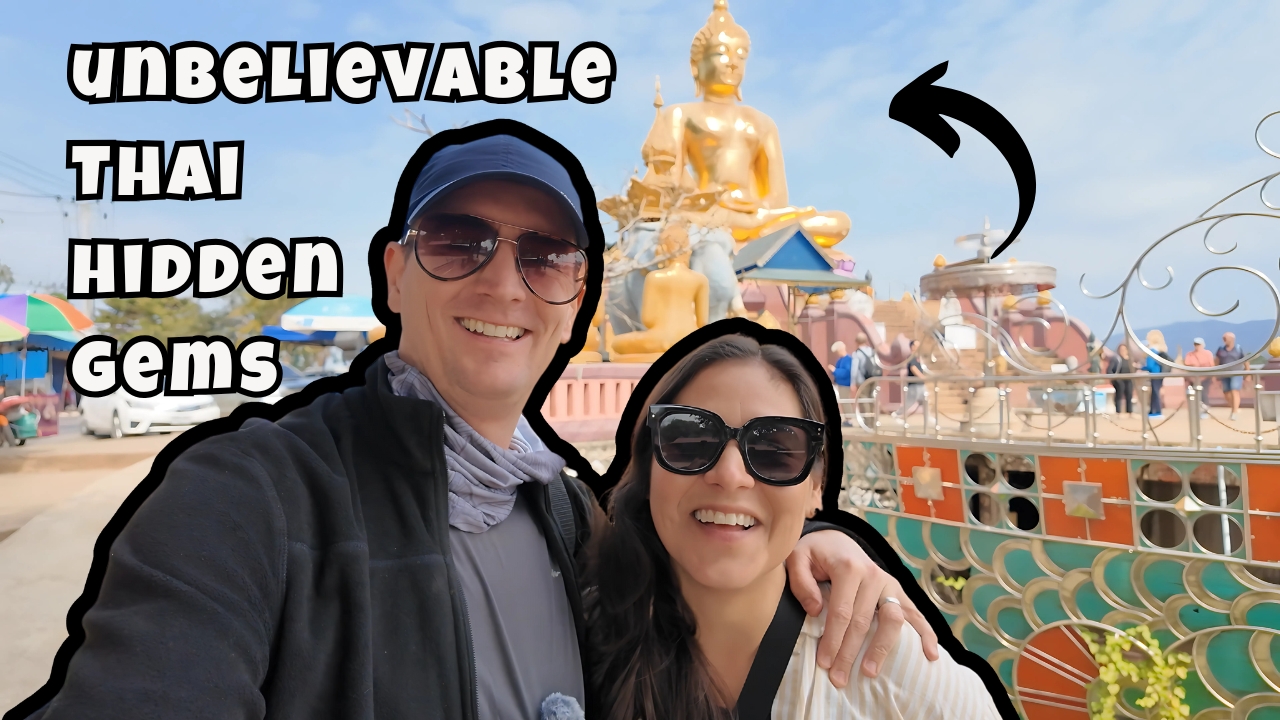Visiting a 15th-Century Stupa in Northern Thailand
One of the most memorable parts of our travel in Thailand was exploring the peaceful countryside just outside Chiang Rai. We arrived early in the day to find a centuries-old stupa — a large brick structure surrounded by five weathered gates and the remains of an ancient wall.
The stupa dates back to the 15th century, with restoration work completed in the 16th. Even without a guide, we could piece together its story through signs and details left behind. The rough, earthy brickwork had clearly been shaped by time, and the layout suggested a terrace, staircase, and even a long-lost tiled roof.
This quiet stop reminded me how unique Thai culture is, especially compared to places I’ve lived like Vietnam. The architecture, the respect for history, and the stillness of the place gave it a kind of spiritual weight. It was a powerful start to what turned into an unforgettable day.
Firecrackers in the Quiet
Not long after leaving the stupa, we were driving through the countryside when the calm was suddenly shattered by the sound of firecrackers. At first, it was one sharp crack in the distance. Then another. Then a burst of them going off just metres away, outside a small temple hidden behind the trees.
We’d heard a few earlier at breakfast but didn’t think much of it. Now it was clear — this was part of the Lunar New Year celebrations. There were no signs, no crowd, no announcement — just the sound of loud explosions breaking through the silence.
It was chaotic, surprising, and very Thai. These spontaneous cultural moments are what make travel in Thailand so exciting. You never know when something unexpected might appear right around the corner.
Standing at the Golden Triangle
From the temple, we headed north and found ourselves standing at one of the most famous and important spots in Southeast Asia — the Golden Triangle.
This is where Thailand, Laos, and Myanmar meet, divided by the mighty Mekong River. You can literally see all three countries just by turning your head. To the left is Myanmar. Across the river is Laos. And we were standing in Thailand, looking at it all from a small hill.
It felt surreal. The river below was calm, but the history here was anything but. The Golden Triangle is known for its past as a center of the global opium trade, and even now, you can still feel the weight of that history. Across the water, we saw large buildings — maybe casinos — which seemed heavily developed. We guessed they were Chinese-owned, though we couldn’t be sure.
It’s a place where borders, history, and global stories collide. And yet, it was strangely peaceful while we were there.
The Hall of Opium: A Dark but Powerful History
Just a short drive from the river, we visited the Hall of Opium, a museum dedicated to telling the story of opium and how it shaped this region. Compared to the nearby Opium House, the Hall was twice the price — and easily worth it.
We entered through a long, dim tunnel carved with haunting faces. It was eerie, symbolic, and completely silent. No signs at first, just atmosphere. Later, we learned it represented the souls destroyed by opium. It set the tone for what was one of the most intense museums I’ve ever visited.
Inside, the exhibits explained everything — from how the East India Company made massive profits trading opium in China, to how the British Empire pushed it to feed their addiction to tea. The displays were honest and unfiltered, showing how addiction spread and how some governments (even Thailand at one point) allowed it to grow for money.
Eventually, Thailand reversed course. They cracked down on production, destroyed poppy fields, and launched serious efforts to end opium addiction. That part gave the whole story a bit of hope, showing that change is possible, even after deep damage.
It wasn’t an easy visit, but it was important. It made me see the Golden Triangle differently — not just as a place on a map, but as a place with deep wounds and deep healing.
Tham Luang Cave: The Rescue That Shocked the World
The final stop of our day was one of the most emotional: Tham Luang Cave in Tham Luang Khun Nam Nang Non National Park, near Chiang Rai.
This is where, in 2018, 12 boys and their football coach got trapped deep inside the cave after a flash flood blocked the entrance. The world watched in suspense as expert divers, doctors, and rescue teams from around the globe came together for what would become one of the most famous rescue missions in history.
The boys were more than two kilometres deep, with no way out. They had no food, very little water, and complete darkness for days. Eventually, divers decided the only way to get them out was to sedate them one by one, and guide them through narrow, flooded tunnels — a method that had never been tried before.
And somehow… it worked. Every single boy survived.
We were only able to walk about 500 meters into the cave, but even that short distance gave us a sense of how terrifying it must have been. Outside, a quiet memorial honours the Thai Navy SEAL who lost his life bringing oxygen to the boys. His photo and story stood as a reminder of the bravery it took to pull off something so impossible.
Standing there, I felt so many things — sadness, respect, and even a bit of disbelief. I never imagined I’d visit this place. But I’m glad I did.
Final Thoughts
This day in Chiang Rai was one of the most surprising and moving parts of our entire trip. From quiet temples to unexpected celebrations, from borders to museums, and from ancient history to recent world events — it was a day that reminded me why I love travel.
Thailand has a way of layering stories together: the spiritual next to the modern, the peaceful next to the chaotic, the beautiful beside the dark. And when you experience it all in one day, it sticks with you.

